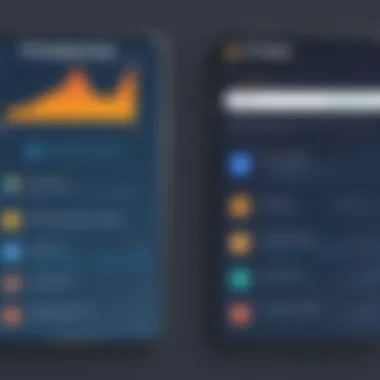Exploring Firebase Alternatives for B2B Solutions


Intro
Firebase has gain significant traction in the realm of web and mobile application development. It is a comprehensive suite that offers various services such as real-time databases, hosting, and authentication. However, this popularity has not come without its limitations. Many developers find that Firebase does not fit all their project requirements. This creates a demand for alternatives that can provide similar or enhanced functionalities.
As we dive into this exploration, we will identify various alternatives to Firebase, analyzing their features, benefits, and potential drawbacks. This will allow project managers, IT specialists, and software developers to make well-informed decisions when selecting the right backend solution for their B2B projects. Understanding these options is crucial, especially in environments where scalability, flexibility, and cost-effectiveness are essential.
Now, let’s dissect the features of various Firebase alternatives.
Preamble to Firebase and Its Use Cases
Understanding Firebase is crucial for anyone involved in web and mobile application development. Firebase offers a range of services that can significantly streamline backend development. It provides tools such as authentication, real-time databases, and cloud storage, catering to the needs of developers. However, like any tool, it has its limitations. This article digs into those aspects, aiming to equip decision-makers and developers to navigate the landscape of backend solutions effectively.
Overview of Firebase Features
Firebase encompasses a variety of features designed to facilitate the development process. Firstly, it provides a real-time database, which allows developers to sync data across clients in real-time. This capability is especially useful for applications that rely heavily on user interactions and immediate updates.
Firebase also offers authentication services that support various sign-in methods, including social media accounts. This simplifies user management and enhances user experience. Another key feature is Firebase Cloud Messaging, which enables developers to send notifications, keeping users engaged.
Additionally, Firebase includes tools for analytics, crash reporting, and performance monitoring. These features collectively help developers optimize their applications, making data-driven decisions easier.
Common Use Cases for Firebase
Firebase is particularly beneficial in several scenarios. Its most common use cases include:
- Real-time applications: Apps that require immediate data updates, such as chat apps or collaborative tools, are ideal candidates. Firebase's real-time capabilities make it easier to manage user interactions.
- Social media apps: These apps leverage Firebase's authentication services to allow users to quickly register and log in. They also utilize cloud storage for image sharing and other media.
- E-commerce platforms: By using Firebase, developers can handle user sessions, manage product inventories, and track user behavior seamlessly through its analytics features.
- Game development: Firebase's multiplayer capabilities provide tools for real-time game interaction, making it a preferred option for gaming applications.
Limitations of Firebase
Despite its strengths, Firebase has limitations that can impact decision-making. One of the main concerns is vendor lock-in. Once a project is deeply integrated with Firebase, transitioning to another solution may prove difficult, affecting long-term flexibility.
Another limitation is the cost structure. While Firebase offers a generous free tier, expenses can rapidly increase as usage scales. This unpredictability can lead to concerns, especially for startups.
Additionally, Firebase may not suit all use cases. For instance, applications requiring complex query handling may find Firebase's database less effective compared to traditional SQL databases. This limitation can restrict developers from using familiar data management strategies.
Understanding these limitations is vital when considering whether Firebase is the right solution for your project. By evaluating both the benefits and restrictions, developers can make more informed choices about their backend options.
Criteria for Evaluating Firebase Alternatives
Evaluating alternatives to Firebase is crucial for developers and business decision-makers who seek to optimize their application infrastructure. Firebase has gained popularity due to its robust features, yet it is not without limitations. The criteria for evaluating alternatives can ensure that organizations make informed decisions based on specific needs and goals. This section will discuss key elements that need to be considered when assessing various backend solutions.
Scalability and Performance
Scalability is a fundamental requirement for any backend solution. Applications often start small and might scale rapidly as they gain more users. When evaluating Firebase alternatives, assess whether the solution can handle increased load seamlessly. Look into how each alternative addresses performance in high-traffic situations. Some solutions offer auto-scaling features that allow users to increase resources automatically during peak times. Analyze the underlying architecture of alternatives to measure the impact on performance. A performance benchmark might be beneficial in identifying which solution meets the responsiveness needs of your application.


Ease of Use and Integration
The ease of use of a backend solution can significantly impact development time and overall efficiency. It is essential to evaluate the complexity of setting up the system and integrating it with existing applications. Alternatives should ideally provide intuitive user interfaces and comprehensive documentation that enhances understanding. Assessing the APIs and SDKs that are available for integration is equally important. A solution with extensive integration capabilities simplifies connecting with other tools and services, ensuring that development teams can work without unnecessary friction. Consider whether the platform supports popular frameworks and libraries to streamline the development process.
Cost and Licensing Model
Cost is a significant factor when selecting a backend alternative. Analyze both initial costs and ongoing expenses. Some alternatives may offer free tiers, which can be a good starting point for small projects. However, it is important to understand the pricing models of different solutions. Some solutions charge based on usage, while others may have flat-rate pricing. A transparent licensing model can prevent future budgeting surprises. Be careful with hidden costs, such as fees for data storage and transfer. A thorough cost analysis can help organizations allocate resources effectively and avoid budget overruns.
Support and Documentation
Adequate support and thorough documentation are critical for any backend solution. Investigate the resources available for troubleshooting and learning. Quality support can make a difference, especially in urgent situations. Assess whether alternatives provide community support, forums, or direct assistance from developers. Comprehensive documentation can facilitate smoother onboarding and help developers utilize the solution effectively. Look for tutorials, guides, and examples that can expedite the learning curve for new users. Reliable support can ensure that the transition to a new backend is as seamless as possible.
"Choosing the right backend solution can significantly improve your application's performance and reduce overhead in development."
Understanding these criteria will refine the decision-making process when exploring Firebase alternatives. Each factor plays a crucial role in achieving a successful backend, shaping the user experience and operating efficiency.
Notable Firebase Alternatives
As the landscape of backend solutions continues to evolve, it is essential to consider various alternatives to Firebase. This section evaluates notable options, each offering unique features and capabilities. Selecting the right backend service is crucial for performance, scalability, and cost-effectiveness. In this part, we will delve into each alternative in detail, outlining their key attributes, strengths, and any potential drawbacks.
Amazon Web Services (AWS) Amplify
AWS Amplify provides a powerful platform for building secure and scalable web and mobile applications. Its integration with various AWS services allows developers to leverage cloud capabilities seamlessly. The Amplify Framework supports multiple front-end frameworks, simplifying deployment and management. One significant benefit is its broad set of tools, including authentication, analytics, and storage. However, the extensive options can also complicate initial setup for new users.
Microsoft Azure App Services
Azure App Services offers a robust cloud platform with a wide range of functionalities for building applications. Its scalability is a key feature, allowing businesses to adapt to changing demands easily. Integration with Visual Studio enhances the development experience. Users appreciate the built-in support for various programming languages. While Azure provides comprehensive resources, the complexity in pricing models can sometimes lead to unexpected costs,
Parse Server
Parse Server is an open-source backend platform that enables developers to build applications quickly without committing to a specific vendor. It offers various features, such as real-time database support and easy data migration. Since it is open-source, developers can modify the source code according to their project requirements. However, self-hosting options might require more operational overhead, which could be a challenge for teams without dedicated server management.
Back4App
Back4App utilizes Parse Server to provide a flexible and user-friendly platform for developing applications. Its strength lies in its ease of use, especially for small to medium-sized projects. Developers can deploy free plans with essential features, allowing experimentation without upfront costs. However, as projects scale, users may find that premium features can become expensive over time.
Supabase
Supabase is gaining traction as an open-source alternative to Firebase. It is designed to create web and mobile applications quickly by providing a scalable PostgreSQL database. Supabase offers real-time features and an intuitive API, facilitating rapid development. Although still in its early stages, its growing community supports fast improvement. Consideration must be given to its current limitations in comparison to more mature services.
Appwrite
Appwrite provides developers with an open-source backend as a service focused on simplicity. It includes multiple essential features like user management, file storage, and notifications. As a self-hosted solution, it takes away vendor lock-in concerns, offering more control over data. However, it may not yet have the extensive feature set of other solutions, which can be a consideration for more complex applications.


Backendless
Backendless offers an intuitive platform that accelerates application development. It features a visual development environment, which simplifies the overall process. Users appreciate its built-in user management and real-time database capabilities. However, some developers note that their documentation may not be as comprehensive as expected, which could hinder onboarding.
Realm
Realm is known for its mobile-first database approach. It optimizes data synchronization for mobile devices, which is essential for users requiring offline capabilities. Realm's intuitive API can be beneficial for developers looking for a smooth learning curve. A drawback includes limited support for non-mobile applications, which may restrict some user scenarios.
Couchbase Mobile
Couchbase Mobile is a powerful database system that combines local data storage with cloud synchronization. The system's architecture allows mobile applications to function offline and sync automatically when connected. Its performance is impressive for large datasets. On the downside, the complexity of setup can be daunting for new developers.
Choosing the right Firebase alternative can have a substantial impact on the overall success of your project. Evaluate each option based on specific project requirements, team expertise, and cost considerations.
Comparative Analysis of Firebase Alternatives
The comparative analysis of Firebase alternatives is crucial for developers and organizations looking to enhance their backend capabilities. As Firebase is often celebrated for its ease of setup and robust features, it is imperative to understand how other solutions stack up against it. This analysis assists in identifying the best features, pricing structures, and user sentiments, providing a clear perspective on what each option offers in various contexts.
Feature Comparison
When evaluating backend solutions, feature comparison emerges as a fundamental criterion. Different solutions possess unique strengths that cater to particular needs. For example, AWS Amplify delivers a wide array of tools aimed at cloud-native applications. In contrast, Supabase positions itself as an open-source alternative that focuses heavily on SQL databases. Users should ask themselves:
- What specific functions are essential for my project?
- How well does each alternative integrate with existing tech stacks?
- Are there specific features such as real-time databases, authentication, or file storage that are non-negotiable for my needs?
This segment must explore how each alternative, compared to Firebase, supports various development requirements, such as scalability and performance. It’s not merely about having multiple features but also functionality.
Pricing Models and Cost Analysis
Cost analysis is another fundamental aspect of the comparative evaluation. Numerous backend platforms adopt varying pricing models, leading to potential confusion for decision-makers. Firebase has a pay-as-you-go method that may work for many, but organizations sometimes encounter unpredictable costs as they grow. By contrast, Microsoft Azure App Services offers tiered pricing, which could stabilize expenses for some projects instead.
Considerations when analyzing costs should include:
- Monthly expenses: Estimate based on potential usage.
- Hidden costs: Identify fees for additional services, like data transfer.
- Scalability expenses: Projects tend to scale, leading to different price scales among alternatives.
Proper assessment can lead to more budget-conscious decisions.
User Experiences and Reviews
User experience plays a significant role in determining the suitability of any backend solution. Developers often share their insights on platforms like Reddit or specialized forums where they outline their practical experiences with different systems.
To gauge user sentiment regarding Firebase alternatives, we should focus on the following:
- Ease of setup: How quickly can a new user get productive?
- Customer support quality: Is responsive assistance available?
- Community engagement: Are there vibrant communities around these alternatives?


User feedback can reveal insights that technical documentation may not express fully. This qualitative data is invaluable for a thorough understanding of actual use cases versus theoretical applications.
"An informed decision stems from more than just quantifiable data; it includes digesting the lived experiences of those who have tread the path before."
Best Practices for Transitioning to a New Backend Solution
Transitioning from one backend solution to another is a critical process that can significantly impact an application's performance and reliability. It is essential for businesses to follow best practices to ensure a smooth migration. This section outlines several key elements and considerations that guide this process effectively.
Assessing Project Requirements
Before making a switch, it is crucial to comprehensively assess the specific requirements of the project. This will involve identifying how the current backend solution falls short and what features are necessary in the new system. Here are some points to consider:
- Functionality Needs: Determine the functionalities that are essential for your application, such as real-time data updates, user authentication, or serverless architecture.
- Scalability: Evaluate how well the new solution can handle growth in user base and data size.
- Integration Capabilities: Assess your current tech stack to ensure compatibility with the new backend.
- Performance Metrics: Establish standards for performance that the new solution needs to meet.
Taking the time to document these needs can help avoid issues during and after the transition.
Data Migration Strategies
Once the requirements are clear, the next step is to strategize how to migrate the data. This is one of the most critical aspects of the transition process. Effective data migration ensures that there is minimal disruption to the application. Here are some effective strategies:
- Incremental Migration: Instead of moving everything at once, consider migrating in phases. This reduces risks and allows for continuous operation.
- Data Cleanup: Use this opportunity to clean up the data, removing any duplicates or obsolete entries.
- Backup Procedures: Always back up your existing data before migration. This provides a safety net in case something goes wrong.
- Testing After Migration: Ensure that data consistency and integrity are maintained after the migration process.
Developing a clear migration plan can facilitate a smoother transition and reduce potential errors.
Testing and Quality Assurance
After migration, rigorous testing is necessary to validate the new backend's functionality. Proper quality assurance processes will ensure that everything is functioning as it should. Here are some steps to follow:
- Functional Testing: Verify that all features work as intended. This includes checking API endpoints and user interfaces.
- Performance Testing: Assess how the new backend performs under load, ensuring it meets the scalability requirements identified earlier.
- User Acceptance Testing: Involve a group of users to test the application from their perspective. This can provide insights into potential issues that developers might overlook.
- Monitoring Post-Launch: Keep an eye on system performance after the transition. Implement monitoring tools to detect any anomalies in real-time.
The success of a backend transition largely relies on thorough testing and quality assurance practices. Following these best practices can minimize disruption, enhance performance, and ensure a successful transition to a new backend solution.
The importance of assessing requirements, planning migration strategies, and performing extensive testing cannot be overstated. A structured approach leads to smoother transitions and successful outcomes.
Finale
The conclusion holds a significant place in the context of this article. It not only summarizes the thorough exploration of Firebase alternatives but also emphasizes the broader implications of choosing the right backend solution. In an evolving tech landscape, understanding how these alternatives align with specific project needs becomes crucial for developers and decision-makers alike.
Key Takeaways
- Diverse Options: The analysis presented different alternatives to Firebase, including Amazon Web Services (AWS) Amplify and Microsoft Azure App Services. Each option has unique features that cater to varied project requirements.
- Evaluating Fit: It is critical for businesses to align backend solutions with their specific technical needs and business goals. Factors such as scalability, ease of integration, and long-term costs should be taken into account.
- Planning Transition: Migrating from Firebase to another solution involves assessment of current data structures, and careful testing. Developers must plan comprehensively to ensure a smooth transition while maintaining system integrity.
Future Trends in Backend Solutions
As the demand for more efficient and flexible backend solutions rises, several trends are shaping the future.
- Serverless Architectures: Companies are increasingly gravitating towards serverless computing, which eliminates the need for infrastructure management. This evolution promotes scalability and reduces operational costs.
- Microservices: The adoption of microservices architecture allows businesses to develop applications as a suite of small services. This shift promotes agility, enabling faster updates and independent deployments.
- API-First Approach: An API-first development philosophy is becoming prevalent. This method prioritizes APIs as the backbone of applications, allowing for better integration with various services and fostering innovation in software development.
- Increased Customization: As developers seek tailored solutions, platforms are evolving to offer more customization options. This ensures that solutions can be shaped according to specific business needs and user demands.
Understanding these trends can provide valuable insights as organizations navigate their backend strategies. Choosing the right solution is not just about current needs but also about future growth and adaptability.







